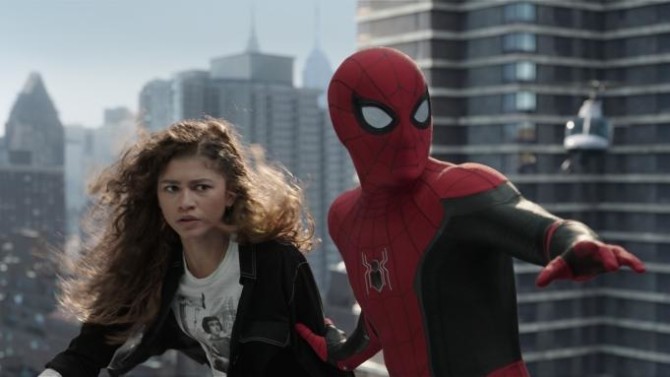Spider-Man saves more than the multiverse. He saves the movie business!
Genre: Superhero
Premise: When Spider-Man accidentally opens up a rift in the multiverse, villains from other universes arrive in our world, determined to eradicate him.
About: Spider-Man No Way Home defied… well… pretty much every expectation in the book, tallying 253 million dollars over the 3 day weekend. That’s better than The Force Awakens and only behind the two-part Avengers finale. There is no other way to describe this opening than, “Wow!” A trivia tidbit for you. All three Spider-Man movies have the word “Home” in their titles. Homecoming, Far From Home, and now, No Way Home.
Writers: Chris McKenna and Eric Sommers
Details: 2 hours and 30 minutes!
You gotta give it to Amy Pascal, Kevin Feige, and Tom Holland. They have found the winningnest of winning formulas with this iteration of Spider-Man. How did they pull it off? Since Spider-Man just beat out Star Wars, let’s use that franchise as a comparison. Kathleen Kennedy once famously said the reason comic book movies have thrived while Star Wars has dived is because every comic book character has 50+ years of comic book stories to draw from. All they have to do is identify which of those stories were successful then, simply, make the movie version of that. From what I understand, the multiverse was a huge success for Marvel Comics. As was the whole “Forget Peter Parker” storyline.
The reason that’s relevant is because the only variable that’s been capable of predicting success in this business is success in a previous form. Whether it be a movie, a comic book, a novel, a podcast. The industry loves verification that something was good somewhere else at some other time. So the ability to cherry pick from 50 years of comics that have had all these popular storylines is a huge advantage.
I’m jealous. Because all Star Wars has is Boba Fett.
Back to our web-slinging friend — Spider-Man No Way Home is a better movie than I thought it was going to be. But it was far from perfect. To convey just how clunky the movie could be, its most critical scene is its worst and its least critical scene is its best. More on that in a minute. But first, if you haven’t seen the film, let’s give you a quick plot breakdown. This film is impossible to discuss without spoilers so if you haven’t seen it, you might want to come back and read this after you do.
Peter Parker has just been exposed as Spider-Man to the world. No more secret identity. Cancel culture than comes for his best friends, MJ and Ned, who are told they won’t be accepted into their dream school, MIT, because they’re affiliated with Spider-Man.
So Peter goes to the crusty old Dr. Strange and asks him to cast a spell making everyone on the planet forget he’s Spider-Man. That way, MIT will accept MJ and Ned. Dr. Strange says fine. But as he’s conjuring the spell, Peter keeps amending it. “Can you make MJ remember me?” “And Aunt May?” “And Ned?” This cripples the spell and opens up the multiverse.
Doctor Octopus takes advantage of this, arriving from a separate world to attack Spider-Man. Then the Sandman. Then Electro. Then the Green Goblin. Doctor Strange constructs a bad guy holding cell, telling Spider-Man to go out, bring the villains back here, so he can conjure another spell to send them back to their own worlds.
But when Peter learns that all of these villains meet their death back in their home worlds (courtesy of other Spider-Men), he wants to “cure” them first so that they don’t fight Spider-Man back on their home worlds and, therefore, live. Since we’ve all watched movies before, we know where this is going.
That’s right. The villains escape and turn on Peter, determined to kill him. Since Spidey knows he can’t defeat four top-level villains all on his own, he recruits two Spider-Men from separate universes and the Spidey-Trio call the villains out to the Statue of Liberty where they ready for the ultimate Spidey Showdown!
Like every comic book movie these days, Spider-Man No Way Home is a mixed bag. For those who want Cheetos, you’re going to have to endure some Ruffles. For those who want Ruffles, you’re going to have to endure some trail mix. You’re going to hate some bites. You’re going to love some bites. And it will be up to the individual to determine whether the yummy snacks outweighed the rancid ones.
Here’s my biggest takeaway from Spider-Man No Way Home. Normally I don’t like overstuffed narratives. I think they’re a writer’s biggest enemy. I think they cause more harm than good 99% of the time. Too many characters and too many storylines just don’t work well within the feature screenplay format.
However, one of the exceptions to this rule is when the “overstuffed” narrative is organic to the concept. No Way Home is all about this rift being opened up in the universe that is allowing things from other universes to come here. That concept requires multiple characters and multiple storylines because all these characters arriving here is organic to the setup.
I’m not sure you open up a multiverse and only allow one villain through. I’m not sure you open up a multiverse and don’t play with the idea of multiple Spider-Mans. With all this stuff being organic to the concept, I was into it.
But I almost wasn’t due to a single scene.
The spell-conjuring scene between Peter Parker and Doctor Strange might have been the worst scene I’ve witnessed in a comic book movie. It was bad on every level. Mainly from the writing. But the acting was awful as well. You could see poor Benedict Cumberbatch grimacing through the the lines he had to read. It played out like an improv class at the Groundlings. There was no structure, no thought as to how to play the scene, no consideration of whether the scene was working or not. You can always tell when a scene isn’t working because the actors try to distract you by adding a lot of improvised jokes.
The reason this scene bothered me so much is that it’s the scene that holds up the entire movie, right? I call these “Pillar” scenes because that’s their job. They have to hold everything else up. Why, then, they insisted on shaky logic and goofiness as the main motivators for the scene, I’ll never know.
It took me a good 20 minutes to mentally get back into the movie again, such was the terribleness of that scene. I can’t believe they didn’t reshoot it. Maybe it was due to a Covid issue.
Luckily, No Way Home had a secret weapon. MORE SPIDER-MANS! This was its saving grace. I thought that seeing the Toby Maguire Spider-Man again was what was going to move me. But it was actually the Andrew Garfield Spider-Man that made the biggest impact on me, despite not liking the Garfield Spider-Man films very much.
For those who don’t know, Garfield had a rocky relationship with Sony as Spider-Man and their relationship ended somewhat bitterly. So to see him come back with such excitement and vigor was heartwarming. It me made feel good. He even delivers a meta-speech to Tom Holland saying, “I just don’t want you to end up like I did. Hating what you’ve created.” And it worked because this was a meta movie from the get-go.
I even got the tingles when the three Spider-Men came together early on in the Statue of Liberty fight and changed their strategy from fighting separately to fighting together. Seeing them swing into action after that moment was really cool (and the crowd cheered like crazy – yay for being back in movie theaters!).
I do think it’s interesting that No Way Home’s best scene was its least relevant one. That tells me there’s something inherently wrong with this comic book formula that they haven’t figured out yet. I shouldn’t be getting the biggest feels during moments that aren’t part of the main narrative. The scene I’m referring to comes after Peter allows Dr. Strange to erase the world’s knowledge of Peter Parker for real this time, and Peter goes to pay a visit to MJ, who no longer knows who he is.
This is a basic “dramatic irony” scenario, as you screenwriting aficionados know. The writer allows the audience to know something that one of the key characters in the scene does not. In this case, they know that MJ has been in love with Peter before. But she doesn’t know this. She doesn’t even know who Peter is. So we get this chill scene where he visits her at work and he wants to tell her who he is… but he realizes he can’t. It’s the quietist scene in the movie yet it’s its best because it’s so emotionally gut-wrenching.
If they could’ve had 4-5 scenes of this emotional magnitude throughout the movie (and no, the melodramatic over-acted Aunt May death was not emotional at all), it could’ve been the greatest Spider-Man movie ever, and up there with the greatest comic book movie.
How does a movie which fails its most important scene and aces its least important still end up being worth the price of admission? BECAUSE IT’S SPIDER-MAN. x3! Watching these spider-boys become spider-besties is cuter than watching three Golden Retriever puppies play with a rabbit. You’re going to love it. Is the rest of the movie clunky? Sure. Does anybody really understand how the Spider-Men are “curing” these villains? Not really. But No Way Home is inarguably fun. So you can bet your Spidey-dollars it’s worth checking out.
[ ] What the hell did I just watch?
[ ] wasn’t for me
[x] worth the price of admission
[ ] impressive
[ ] genius
What I learned: This movie taught me that dramatic irony works even better when the stakes behind the dramatic irony are high. In the scene I highlighted above, when Peter talks to MJ, the secret isn’t that he’s going to break up with her. That’s still dramatic irony but it’s low stakes dramatic irony. The secret is that she once knew him and they were madly in love and a couple. The stakes of that secret are enormous, which is what makes that final moment between them so powerful.



